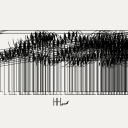Hello, the first part to this thread is this: (https://forum.pdpatchrepo.info/topic/10707/all-possible-permutations-with-repetitions-of-harmonic-volume-from-top-to-bottom)
Can someone get this patch to work? 1493807936933-combinations(3).pd 1493807936933-combinations-help(3).pd I use pd extended version 0.42.5, and I can´t get the list printed, various objects are in dotted rectangles, i tried downloading normal pd or vanilla and it didn´t work either and practically everything I tried couldn´t be created, dotted rectangles, so I came back to extended, which is the best for me when using mrpeach and Iannix which is all the time.
I´m a composer and know very little about programming, just what I need to know to make my music work...
I figure that the next step would be to put the 8 sine waves and assign each letter a volume percentage, then control the list via slider/curve.
Thank you for the help!
-
Permutations, second part, can anybody get this patch to work?
-
if you use an abstraction in a patch you need to name it exactly as the abstraction is named. in your case you have to rename the abstraction into "combinations.pd".
-
@Pándinus combinationrepair for extended.zip
David. -
I think the list finally worked, thanks guys! now i have to connect these symbols to the percentages of the sliders, right now I only know how to add the sine waves hehe...
-
@Pándinus percentage.pd

David. -
@whale-av 1 voz 1 intensidad.pd maybe join the two?
-
Ill try and make a better one
-
@whale-av this one is better i think, 1 voz 1 intensidad.pd now, the last part...
-
@Pándinus I am not understanding.......
What are the strings from /curve and are they relevant apart from the midi note?
/curve 3 s f f f f f
/curve 4 s f f f f f
and how do you want to use them?
Or do you manually set the oscilator volume values for each /curve 3, /curve 4 etc.?
Does this have anything to do with your other thread? aaaa, aaab etc.?
Where does aaaa, aaab etc come from (I assume those are going to control the volumes..... and at what time do they arrive and what triggers them?
[combinations] would send them a rapidly as it can so your whole curve would last a few milliseconds...
David. -
@whale-av Thank you for the correction, David. i added a few things, it should be fully functional in extended now: combinations-extended.zip
-
@whale-av route 3 is a curve for pitch, and route 4 would control the timbre or the list of combinations of the percentages of the volumes, but its confusing for me I don't know if the 8 sine waves belong on route 3 or 4,
What triggers the list is the curve,,, if for example, the timelines cursor on iannix is at the middle of the curve vertically the list should be at the middle or past half of all the list.
And I dont know if mtof is relevant on the curve controlling the timbre. -
@whale-av I think I will not be putting mtof on the curve on route 4, but yeah, the list and speed of the list is determined by route/curve 4
-
@whale-av so route /curve 4 would control the timbre of route / curve 3
-
i just build this baseconverter. It converts a decimal integer to a number system that is defined by a given list: baseconverter.zip
For example, it converts decimal to binary or hexadecimal.
@Pándinus, with this you could possibly play your combinations live, without generating them beforehand. The decimal limit is 99999999 though.
-
@Ale-H.H. Hello new-born!
Here is an attempt using abcd from [combinations]
I think that if you try to use abcdefgh then the permutations will be too many for a working patch, but you could calculate for the other 4 oscillators maybe...............
For this patch the input range from timbre will have to be 0-255....... scale it as required.
maybe.zip
David. -
@whale-av Hello
 !! I have a lot of questions... what does 0-255 represent? what is this range? and where would the curve 4 enter? Because now it says "s timbre", isn´t there a way to connect curve 4 to an inlet that moves the whole combinations of the list? the curve works from 0 to 1, maybe making a proportion of the whole list of 0 to 1, or equaling the whole list to 0 to 1 and then "box" the list and then connect the curve to it´s inlet... by "box" i mean closing the list and then connecting the curve to it´s inlet, once it can identify any combination between 0 and 1.
!! I have a lot of questions... what does 0-255 represent? what is this range? and where would the curve 4 enter? Because now it says "s timbre", isn´t there a way to connect curve 4 to an inlet that moves the whole combinations of the list? the curve works from 0 to 1, maybe making a proportion of the whole list of 0 to 1, or equaling the whole list to 0 to 1 and then "box" the list and then connect the curve to it´s inlet... by "box" i mean closing the list and then connecting the curve to it´s inlet, once it can identify any combination between 0 and 1.
Like for example a curve for intensity, i would just connect it to the amplifier´s right inlet and the curve would control its volume...
I think that if this works, this would be a new way of morphing instead of just morphing 2 or 3 sounds... this would be a morphing of any quantity of sounds.
yeah 8 sine waves with 4 volume percentages each is a lot, I imagine a super radical morphing timbre
I imagine writing everything in iannix without having to move anything manually in pd, so if i write in iannix a curve that starts at the top, the list on pd would set the volumes of the 8 sine waves with whatever combination is at the top of the list. -
If what I wrote already exists in "maybe" i just cant see it, its a bit overwhelming!
-
@Ale-H.H. I have to admit that I am not understanding much about the outputs from iannix...........
I understood that /curve 4 x...... x = timbre = relative volumes of oscillators.Is it that /curve 4 controls just the final volume?
What do the other curves do?If you did want such a "super timbre" then you can scale to 0-1 easily like this........
maybe2.zip
If /curve 4 is just the volume then, as you say, just feed the 0-1 output to the right inlet of a [*~ 1] that is inserted in the audio chain before the [dac~].The [pd option1] sub-patch takes its input (now 0=0 1=255) and selects the relevant a, a, a, a to d, d, d, d combination........
David. -
@whale-av curve 4 will control the list of all the possible combinations of the 8 sine waves´s volumes, curve 4 controls the list, and curve 3 controls the pitch of the curve,
so you have 2 curves, one for pitch and one for ITS timbre
ok so maybe curve 4 goes in the subpatch right? right where it says "r timbre"? -
@Ale-H.H. Yes, it's already connected (I hope)...... [s timbre] takes output of /curve 4 multiplied by 255 and sends it to [r timbre] inside [pd option1]
David. -
ok so its time to test then




